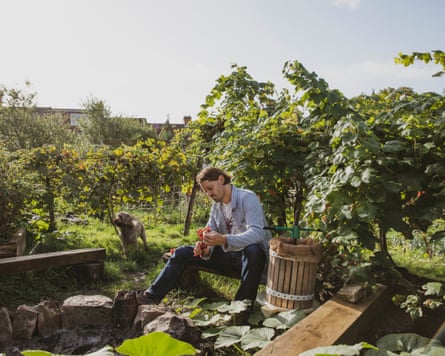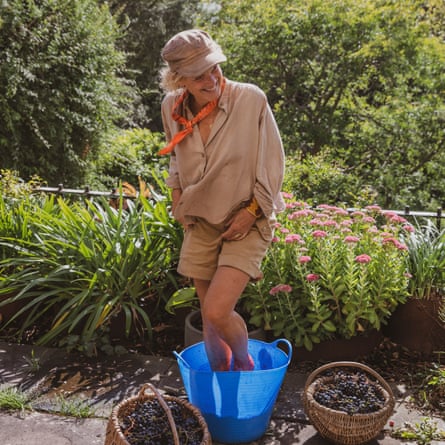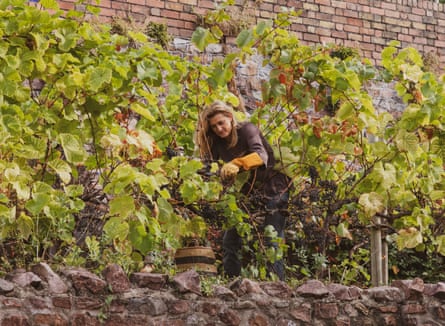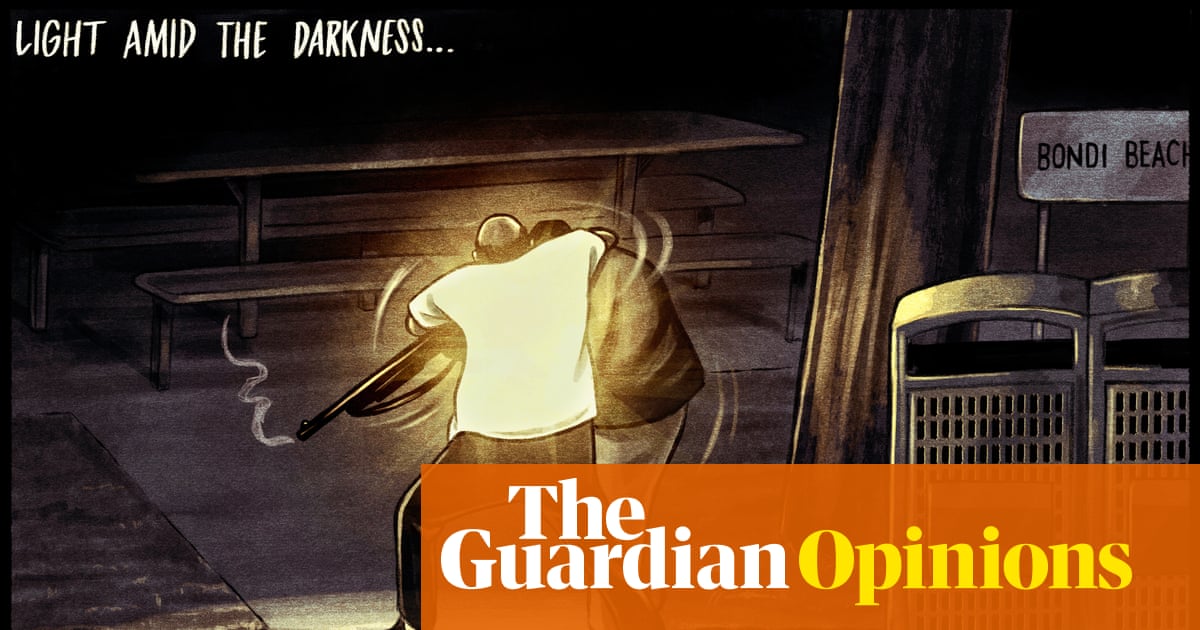Every 20 minutes or so an ageing diesel train pulls into a graffiti-covered station. Nearby, a police siren pierces the near-constant traffic drone. Commuters hurry past collapsing, ivy-draped fencing panels as rain clouds gather.
This is perhaps the last place you expect to find a perfectly formed vineyard. But James Bayliss-Smith has managed to cultivate 40 mature vines sagging with plump mauve grapes on a rambling allotment sandwiched between a row of 1930s houses and a local rail line just north of Bristol town centre.
“I’ve seen people hiding heroin or whatever in those bushes,” says Bayliss-Smith. “But you just get on with it … and keep tending to your vines.”
Bayliss-Smith, 46, a documentary cameraman who also has a kombucha drinks business, is not the only local vintner. He has pulled together a loose collective of growers who make wine from four hidden urban vineyards tucked away in back gardens and allotments across Bristol. It is too clandestine to have an official name yet, but the collective’s WhatsApp group is called Grape Expectations.

So far, Bayliss-Smith’s allotment is the only one listed in the Urban Vineyards Association’s forthcoming world atlas, which includes more famous city vineyards such as the 1,800 vines on the slopes of Paris’s historic Montmartre neighbourhood and more than 3,000 vines overlooking and within Turin. The Italian-based non-profit association is at the forefront of a movement re-establishing city vineyards in traditional winemaking countries, but has discovered them all over the world, including cities in Japan, Bangladesh and Uzbekistan.
The association’s president, Nicola Purrello, insists urban viticulture offers city dwellers much more than just wine. “Vineyards help cities stay greener and more diverse. They protect land from construction by establishing permanent, productive agricultural units inside cities,” he says, on a video call from Sicily. Like all wines, those created in urban areas are a product of the soils the vines grow in, the vagaries of the weather and the people who tend the grapes. “A bottle of wine represents the beauty, community, landscape and history of a city,” adds Purrello, who manages a vineyard in Catania, east Sicily.
Back in Bristol, Bayliss-Smith is in a race against time to harvest the vines he grew from a plant left in his allotment by a Polish family. If the rain comes, then the pigeons may seize their chance to attack again. “This is the mystery Polish grape,” he says, as he cleans damaged and mouldy grapes on the glistering bunches. “We don’t really know what variety they are, but they’re definitely disease-resistant. Unlike noble varieties – Pinot Noir, Chardonnay and other famous French grapes – you don’t have to spray them with chemicals … this is possibly a special variety that was developed by the Soviets.”

The other members of the collective are also making the most of sunny interludes between bursts of autumn rain. On the terrace overlooking Bristol’s shimmering harbour, where medieval merchant vessels once bobbed with barrels of wine from France and Spain, Katy Grant is collecting her rondo grapes from about 50 vines. “I love the smell of these vines. It is so evocative,” she says, pausing with a basket of grapes slung over her arm. “It’s the scent of Provence when you open the car windows on holiday.”
Grant, 52, who has spent over 20 years working for humanitarian organisations in conflict zones, inadvertently inherited the vineyard when she moved back to the UK from Kenya with her family in 2018 . She felt an overwhelming duty to look after the vines in the garden of their new home. “This vineyard has already survived three different owners,” she says. “I really like the idea of natural stewardship – of passing this on to someone else so they can continue producing from this land.”
A short walk away, the final two members of the collective are hard at work on the precipitous slopes of Avon Gorge. Jo Scofield has cultivated more than 150 vines perched on terraces in her wild half-acre garden, which tumbles down towards the muddy River Avon. “People are always surprised,” she says, gesturing towards the tangled vineyard. “They can’t believe they can see rows of vines in a city street.”
after newsletter promotion
Today, Scofield, 60, is picking bunches of dusty purple Rondo grapes from rows of vines slung across the cliff-side with the help of her daughter, Luca. Scofield, a wildlife and conservation film-maker who has worked on Netflix’s Great National Parks series and BBC Two’s Gardeners’ World, was inspired to plant grapes after seeing her neighbour’s vines. She’s discovered that amateurs can make interesting, enjoyable natural wine, which can sell for upwards of £7 a glass in the growing number of wine bars specialising in minimal-intervention wines. “It’s just incredibly satisfying that you can actually make good, natural wine,” she says. “It’s very on trend, but really it’s resurrecting an old way of making wine.” But don’t take her word for it: former Guardian wine writer Fiona Beckett tasted one of her wines this year. “She was shocked: she loved it,” says Scofield. “She said she’d drink our wine any day of the week,”

The ripe grapes are foot-stomped on the sun-dappled stone terrace of her bohemian Georgian flat she shares with her daughter and husband. “When I tread the grapes, all the wild yeasts come off the skins into the juice,” says Scofield, ankle deep in a bucket of tiny stems, pips and crimson juice. “That’s how wines were made traditionally, but industrial wineries add sulphur [dioxide] to kill the wild yeast and then add a lab-grown yeast.”
A few doors down sprightly retiree Bob Reeve, who inspired Scofield to plant her vines, has gathered his friends to pick Chardonnay grapes from the 100 vines he has laid out neatly across two terraces. Reeve, a Lancashire-born PE teacher who taught at Bristol University developed a passion for wine on annual sporting trips to France. But it is a challenge to grow Chardonnay grapes in the dampness of the gorge, with cooling tides sweeping in and out from the Bristol Channel. “I wanted to make Burgundian wines here, which is a bit bonkers,” says Reeve with a smile. “Chardonnay is late to ripen and very sensitive to mildew.”
The temperamental Bristol climate is not the only problem faced by winegrowers. Reeve has had to install a barrier on the steps leading into his garden to stop badgers devouring his grapes, but – perhaps in admiration for the animals’ good taste – has named his vineyard in their honour: “We called it Badger Bluff because we found a way to keep them out.”
The picking, making and drinking of the wine often brings the collective together. Today, Bayliss-Smith is testing the grape juice for sugar levels, which determine the eventual alcohol content. He is keen to stress that vine cultivation can be done in any garden – and that fermenting natural wines is feasible for anyone willing to brave sometimes funky but often wonderful flavours generated by wild yeasts. “We are not wine snobs,” he adds, “we just love experimenting.”

 1 month ago
46
1 month ago
46

















































